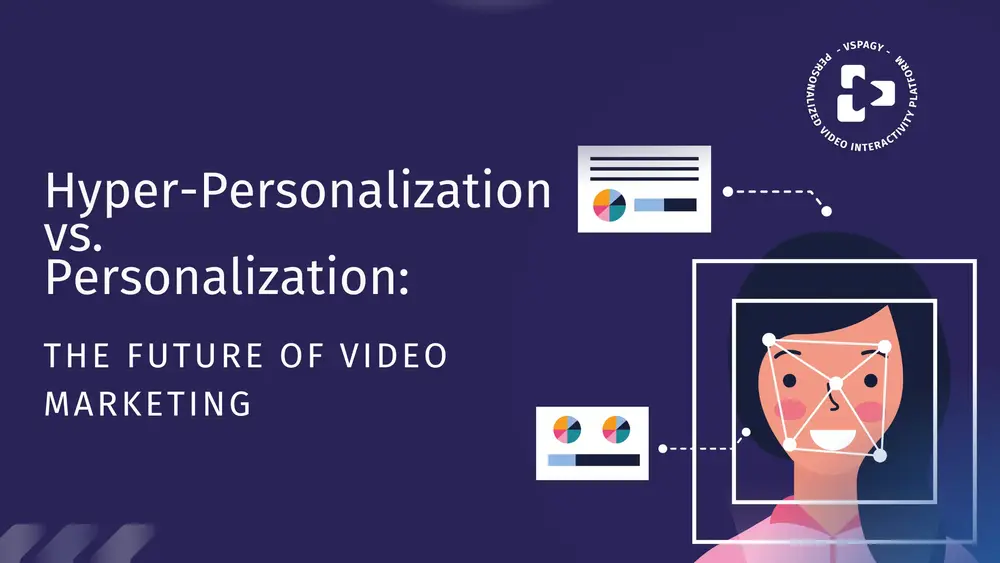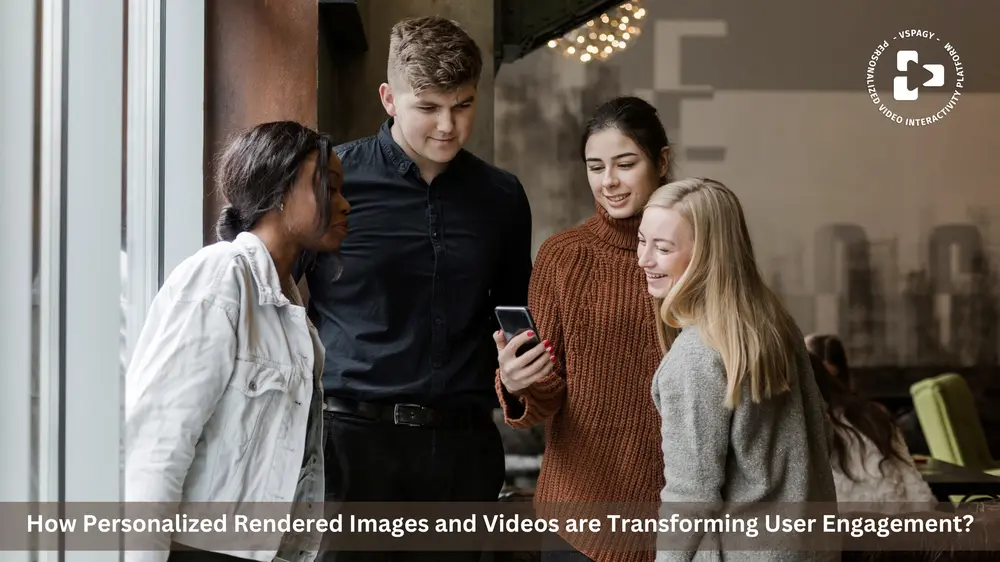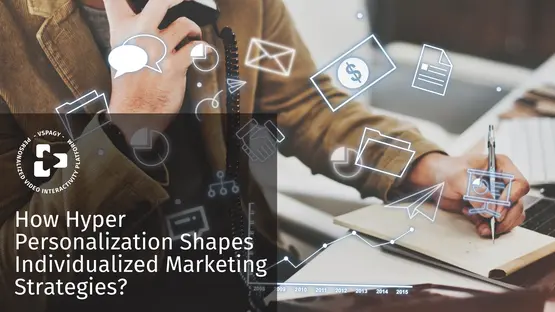Hyper-Personalization vs. Personalization: The Future of Video Marketing
May 13, 2024

Introduction
Personalization is the method of customizing services or products to meet the wishes of a particular character or organization. Personalization, as the call implies, is centered on the individual, meeting the needs of a particular customer, and incorporating those desires into the coolest or carrier.
Personalized marketing gives customers unique items or offerings based totally on records you've gathered about their activities. This can include whatever from their region and age to their search history and purchasing choices. The degree of customization you can observe relies upon the amount of information you get. There are numerous benefits to personalization. It can enhance engagement and revenue and help agencies in testing and enhancing their messaging and goods to meet the desires of their goal marketplace.
The Rise of Hyper-Personalization
A range of reasons led to the emergence of hyper personalization as a fashion in consumer stories and advertising. These factors include improvements in the era, the growing importance of digital and social media systems, the choice of customers for tailor-made reviews, and the considerable utility of synthetic intelligence (AI) and system studying to patron enjoy and advertising plans.
Technology improvements have made it possible for companies to accumulate, observe, and act upon huge volumes of patron facts easily and cheaply. Consequently, corporations might also now target their advertising efforts and have a deeper knowledge of their customers' preferences. Given that they made it possible to obtain priceless patron information, virtual channels play a massive function. Companies might also create hyper-personalized studies by way of the usage of these systems to tune user behavior, preferences, and hobbies.
Consumer demand for extra applicable and helpful interactions with brands is another factor contributing to the emergence of hyper personalization. Customers increasingly count on stories that are custom designed to meet their specific needs and tastes because there may be a considerable number of statistics and options to be had online. Therefore, groups who can offer particularly customized reviews and content material will have an advantage in preserving and attracting their consumers. The improvement of hyper personalization has also been a considerable help in using synthetic intelligence (AI) and machine-getting to know (ML). By processing and analyzing sizable volumes of facts in actual time, those technologies permit organizations to create personalized purchaser experiences and create predictive models.
Benefits of Hyper-Personalization in Video Marketing
Hyper-personalization aids companies in producing more relevant and individualized consumer experiences. It entails offering goods, services, or content that are customized to meet the needs or preferences of specific clients. Many advantages can result from using hyper-personalized video messages, such as increased sales revenue, better communication targeting, more client engagement and loyalty, and ultimately increased market success.
-
Possibility of raising customer satisfaction by offering tailored advice based on prior actions and preferences.
-
Increase conversions by presenting offers to user groups that they are most likely to interact with.
-
By delivering satisfying experiences, you may lower attrition rates and enhance retention strategies.
-
Make quick work of developing specialized solutions to enhance client experience journeys by utilizing artificial intelligence (AI) tools.
-
Acquire a deeper understanding of the tastes and behaviors of audiences to strengthen your competitive positioning.
Challenges and Considerations
For any organization, the process of implementing hyper-personalization can be difficult. They must have a thorough understanding of and know how to use their consumer data. To develop experiences that are specifically catered to the needs and tastes of their clients, companies must thus gather the appropriate data. Correctly utilizing this technology requires several procedures, thus no one is unable to do this.
Getting enough precise consumer data and then having the tools to correctly evaluate it is one of the main obstacles to hyper-personalization. To send emails or other marketing channels with more relevant messages, businesses must find patterns within their consumer base. Organizations handling personal data must also abide by regulatory laws.
When using highly customized videos, businesses need to be mindful of these potential issues:
-
Efficiency: Maintaining efficiency without overburdening internal staff members requires striking a balance between offering content individualized marketing.
-
Data accuracy: The quality of consumer data must continue to be good. If not, there will be a far higher chance of providing false information.
-
Time commitment: Marketing with hyper-personalized video messages requires time. As a result, companies need to commit enough resources to develop tailored campaigns for every market or type of customer.
Businesses that successfully integrate hyper-personalization stand to gain a great deal from enhanced consumer engagement and loyalty as well as higher conversion rates. Businesses that consider each of these aspects will be in a good position to benefit from this effective instrument when used properly.
Difference between Hyper-Personalization and Personalization
| Aspect | Personalization | Hyper Personalization |
|---|---|---|
| SCOPE | Focuses on user groups or preset standards | Focuses specific usersn |
| FOCUS | Extensive personalization | Smooth personalization |
| ANALYSIS | Utilizes fundamental user data. | Makes use of real-time data analysis and advanced services |
| DEGREE OF CUSTOMIZATION | Offers user segment personalization. | Offers users access to expert experiences |
| EXAMPLE | Personalized article recommendations from the news app | An e-commerce app that provides tailored product recommendations based on reviews, situations, and browsing history. |
Frequently Asked Questions
How do you implement hyper-personalization?
Customers can implement customized incentives based on their past purchases and favorite times of the day when you use hyper-personalization techniques. By improving engagement, this strategy can help you develop customer loyalty and retain them.
What is the impact of hyper-personalization?
The application of hyper personalization can yield numerous advantages, such as enhanced client engagement and loyalty, increased revenue from sales, more precise communication targeting, and ultimately, better market success. Customers can receive customized incentives according to their time preferences and past purchases.
What is the future of hyper-personalization?
Hyper-personalization is not limited to advertising. It can be utilized for several customer journey elements, such as product customization, customer support interactions, and website experiences. Businesses may set themselves apart from their rivals by creating smooth, enjoyable experiences that are customized for every client touchpoint.
How does hyper-personalization affect customers?
The hyper personalization maximizes every client connection in real-time. You may make the buying experience more engaging and pertinent by customizing offers, product recommendations, and experiences to each customer's tastes. This increases the possibility that site users will become paying clients and promotes recurring purchases.
Conclusion
Companies can create customized experiences that increase customer satisfaction and revenue by utilizing hyper-personalized video messages. With the right tools, you can pinpoint your target audience and develop products, content, and marketing messages that are specifically catered to their requirements. There are certain disadvantages to hyper video personalization as well, such as the requirement for extensive data collection to generate accurate customer profiles. Businesses collecting this data must also be aware of privacy regulations to prevent legal issues.
Check out related blogs here:
-
Hyper Personalization Shapes Individualized Marketing Strategies.
-
Creative Video Overlays for Edits
-
Short Advertisement Videos with Personalized and Interactive Flair.




